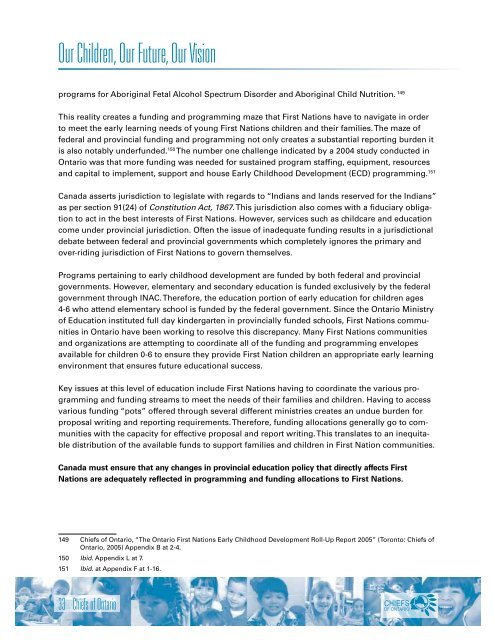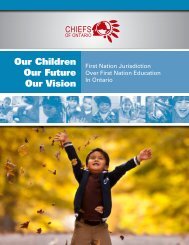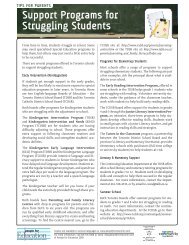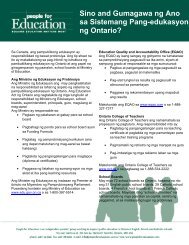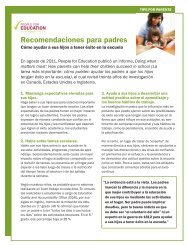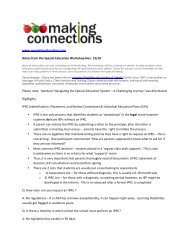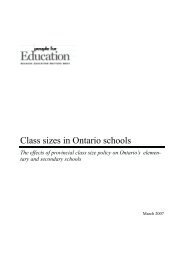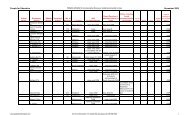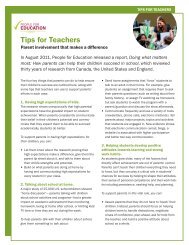Our Children Our Future Our Vision - People for Education
Our Children Our Future Our Vision - People for Education
Our Children Our Future Our Vision - People for Education
You also want an ePaper? Increase the reach of your titles
YUMPU automatically turns print PDFs into web optimized ePapers that Google loves.
<strong>Our</strong> <strong>Children</strong>, <strong>Our</strong> <strong>Future</strong>, <strong>Our</strong> <strong>Vision</strong><br />
programs <strong>for</strong> Aboriginal Fetal Alcohol Spectrum Disorder and Aboriginal Child Nutrition. 149<br />
This reality creates a funding and programming maze that First Nations have to navigate in order<br />
to meet the early learning needs of young First Nations children and their families. The maze of<br />
federal and provincial funding and programming not only creates a substantial reporting burden it<br />
is also notably underfunded. 150 The number one challenge indicated by a 2004 study conducted in<br />
Ontario was that more funding was needed <strong>for</strong> sustained program staffing, equipment, resources<br />
and capital to implement, support and house Early Childhood Development (ECD) programming. 151<br />
Canada asserts jurisdiction to legislate with regards to “Indians and lands reserved <strong>for</strong> the Indians”<br />
as per section 91(24) of Constitution Act, 1867. This jurisdiction also comes with a fiduciary obligation<br />
to act in the best interests of First Nations. However, services such as childcare and education<br />
come under provincial jurisdiction. Often the issue of inadequate funding results in a jurisdictional<br />
debate between federal and provincial governments which completely ignores the primary and<br />
over-riding jurisdiction of First Nations to govern themselves.<br />
Programs pertaining to early childhood development are funded by both federal and provincial<br />
governments. However, elementary and secondary education is funded exclusively by the federal<br />
government through INAC. There<strong>for</strong>e, the education portion of early education <strong>for</strong> children ages<br />
4-6 who attend elementary school is funded by the federal government. Since the Ontario Ministry<br />
of <strong>Education</strong> instituted full day kindergarten in provincially funded schools, First Nations communities<br />
in Ontario have been working to resolve this discrepancy. Many First Nations communities<br />
and organizations are attempting to coordinate all of the funding and programming envelopes<br />
available <strong>for</strong> children 0-6 to ensure they provide First Nation children an appropriate early learning<br />
environment that ensures future educational success.<br />
Key issues at this level of education include First Nations having to coordinate the various programming<br />
and funding streams to meet the needs of their families and children. Having to access<br />
various funding “pots” offered through several different ministries creates an undue burden <strong>for</strong><br />
proposal writing and reporting requirements. There<strong>for</strong>e, funding allocations generally go to communities<br />
with the capacity <strong>for</strong> effective proposal and report writing. This translates to an inequitable<br />
distribution of the available funds to support families and children in First Nation communities.<br />
Canada must ensure that any changes in provincial education policy that directly affects First<br />
Nations are adequately reflected in programming and funding allocations to First Nations.<br />
149 Chiefs of Ontario, “The Ontario First Nations Early Childhood Development Roll-Up Report 2005” (Toronto: Chiefs of<br />
Ontario, 2005) Appendix B at 2-4.<br />
150 Ibid. Appendix L at 7.<br />
151 Ibid. at Appendix F at 1-16.<br />
33 Chiefs of Ontario


